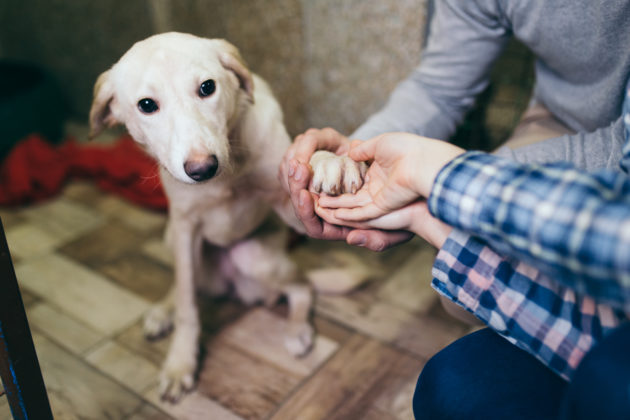A behind-the-scenes look at the physical, mental and emotional rehabilitation efforts that give shelter and rescue dogs a second chance at life.
While some dogs in shelters and rescues have healthy bodies and minds, others aren’t so lucky. Every day, rescue organizations and animal shelters bring in four-legged victims of neglect and abuse – some who are close to death – and it’s up to the staff and volunteers to provide the rehabilitation these canines require. The rehab process varies widely from case to case, but established shelters and rescue organizations have plans and policies in place to ensure every dog receives the care he needs. Let’s take a closer look at how they do it.
Rehabilitation begins at intake
When a dog is brought to a shelter, an intake examination determines his physical and emotional state. At larger organizations, this assessment is performed by a variety of experts, and can take anywhere from one hour to multiple weeks. In foster-based rescues, the foster parent and a veterinarian work together to determine if additional experts are required.
The initial assessment helps shelter staff determine the next best steps for each dog. If a dog shows few to no signs of physical or emotional trauma, he’s fast-tracked toward the end goal — adoption. Behavior consultants, veterinarians, vet techs, shelter team leaders, managers and volunteers all play a role. “Depending on the dog, he may start spending more time with volunteers, and once assessed by a behavior consultant may begin going for sleepovers and outings,” says Haylee Heisel , Dogtown Behavior Consultant at Best Friends Animal Society, the nation’s largest no-kill sanctuary for companion animals. “Dogs who are shy or defensive will start relationship-based training programs to help build their confidence so they can become more adoptable.”
“Dogs who are shy or defensive will start relationship-based training programs to help build their confidence so they can become more adoptable.”
A long and winding road
For many dogs, preparation for adoption can take years. Once any pressing medical issues are addressed, shelter staff and volunteers take steps to overcome any emotional hurdles preventing the dog from living a happy life. Some canines, for example, display behavior problems such as aggression and anxiety, and lack basic obedience skills.
But perhaps the most challenging problem to overcome – and the most common – is fear. “Dogs can be fearful due to lack of socialization, or to past experiences that were negative or traumatic for them,” says Haylee. “Some dogs with fear issues tend to run away or shut down, while others bark, lunge, or even bite. Through science-based training methods, we can start to change a fearful response to a more positive emotional one.”
Depending on the case, various remedies and behavior modification techniques are used to rehabilitate dogs. “For calming, we have found natural hormones, melatonin or lavender oils to be helpful,” says Deb Marsh, President of Blind Dog Rescue Alliance (BDRA), a foster-based non-profit that rescues blind and visually-impaired canines. “The Thundershirt or a snugly-fitting T-shirt gives the same comforting effect. Unfortunately, there isn’t a ‘one size fits all’ remedy, just a lot of trial and error.” The key is finding products or techniques that make a dog feel comfortable and relaxed, and using plenty of positive reinforcement to instill these calm emotions.
Adoption and beyond
In most cases, a dog’s rehabilitation at the shelter or rescue is just the beginning. His adoptive parents are responsible for providing care for the rest of his life, so the right fit is crucial. Rescues take steps to match each dog with the perfect family to ensure he’ll continue to thrive once he leaves the shelter.
“We consider most of our dogs to be adoptable if the interested person is the right fit,” says Haylee. “We’re always striving to find ways to individualize training and environmental management so we can place the right tools in our adopter’s hands and set everyone up for success.”
Often, a successful adoption rests on adequate education. The staff or foster parent talks to potential adopters to relay everything about the dog – what he likes/dislikes, how to handle certain situations, what commands/training tools they have been using, and more. “They give the adopter the best information to prepare for a smooth transition,” says Deb. BDRA has a flyer of tips for living with a blind dog that they include in their adoption package, while Best Friends offers written “well-being plans” to new pet parents, outlining steps essential to a dog’s success in his new home.
Most shelters also make themselves available to new adopters in case any questions arise over the first few months. They understand that the process is ongoing, and that keeping the lines of communication open is fundamental to setting the dogs up for success. Moreover, this final step in the rehab process helps keep dogs in their adoptive homes, preventing the cycle from starting all over again. After all, despite the incredible programs in place for rehabilitating rescue dogs, not having any dogs to rehabilitate in the first place would be even better!
Case study #1 – Radar
Radar came into BDRA’s foster care program in 2013. He was found sleeping on a paper plate in an alley in Baltimore – at the time, he weighed only 1½ pounds. He was dehydrated, emaciated, had sarcoptic mange, and both his eyes were ruptured and infected.
Radar’s foster mom gave Radar sub-Q fluids every couple of hours, and tiny bits of food every half hour, to keep him from becoming hypoglycemic. He was taken to the vet for fluids, and it was decided he would be given medicated baths and lime dips to treat his mange, because he was too weak for stronger treatments. (Conventional medications are required for severe cases of mange.) He was bathed and dipped twice a week for a few weeks, and his foster mom continued with round-the-clock feedings and sub-Q fluids until he grew strong enough to drink on his own.
Mange is contagious, so Radar’s foster mom wore gloves and a gown to interact with him. Since he was not able to have animal company, he was given washable toys to enrich his environment, and his foster mom began clicker training him. Radar was on a number of antibiotics and conventional medications. He was eating a partially raw diet, and raw goat’s milk helped increase his intake of pre- and probiotics. He began steadily gaining weight and maintaining good hydration, and his blood sugar levels stabilized.
After a month, Radar was switched to a more effective mange product, which was applied topically every two weeks. Soon, he was able to play outside with his four-legged foster brothers. Two months later, Radar was strong enough for eye surgery. He required enucleation in one eye, but the other healed well.
Radar now lives at his forever home, competing in nose work and agility. He is also a therapy and reading assistance dog.
Case study #2 – Greta
Greta was living in the woods of Indiana when she was discovered. She was so fearful of humans that she had to be live trapped. Greta could not be safely touched when she first arrived at Best Friends, and she was not comfortable in the presence of humans.
The staff focused on finding her a very people-friendly dog companion to begin her rehabilitation process. Dogs who are fearful of humans, but get along with others of their own kind, often benefit enormously from having a role model dog they can bond with. Watching the other dog enjoy positive interactions with people can help the rescue learn to trust again.
After about six months at the sanctuary, Best Friends staff started to see significant progress in Greta. Her caregivers were able to slip a lead on her to take her for a walk. She also started approaching them when her canine friend sought attention. The staff encouraged this behavior by giving Greta treats.
Soon, volunteers were able to hand-feed her. She started to accept interactions, then began to seek them out. They were able to put a body harness on her, teach her to get in the car, and take her to new places. This process took about two years in total.
Finally, Greta had made so much progress that she was adopted, and is now living very happily in her new home, where she is now known as Cynder. She lives with cats, another dog, and is starting to go hiking with her family.

